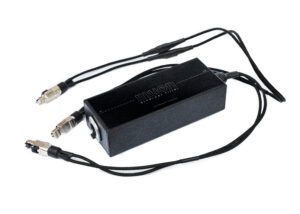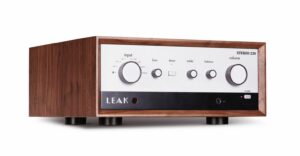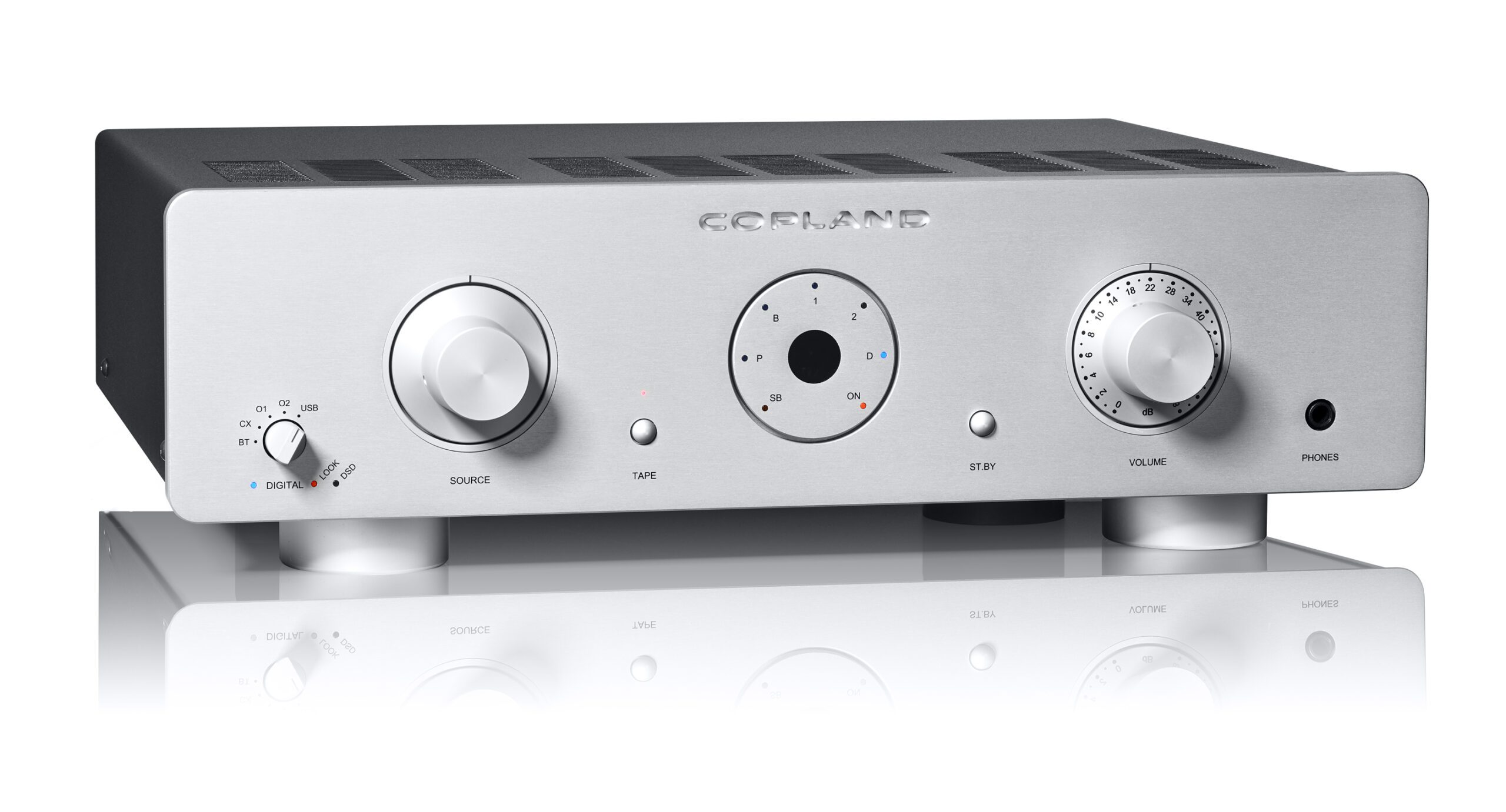
Back in issue 194, Chris Thomas got to grips with the then-new CSA 150 integrated amplifier from Copland. The Copland hybrid amp project wasn’t simply one amp; there are three in the range. The CSA 100 is the middle model, and it might just be in the sweet spot of the trio.
You see, the Copland CSA 150 is the big hitter, delivering – as the name suggests – a hefty 150W into eight ohms, and standing at 164mm high is quite a big beastie on the shelf. The CSA 100 – also as the name suggests – delivers a still impressive 100W into eight ohms, but cutting some 29mm off the height, shedding a kilo of shipping weight and shaving a grand from the asking price makes a surprisingly big difference. When you consider that the last represents a one-fifth drop in the total price of the amplifier and that many CSA100 amps will be used in systems that never get close to using all of its 100W in reality, you can see why these differences might just make all the difference.
Hybrid Listening
Having recently covered the CSA 100’s bigger brother in the magazine, I am mindful of not going over old ground. However, it’s important to show just how similar these amplifiers are in specification terms, because they share a lot in common in musical terms as a result. Copland started life some 30 years ago in Denmark. The founder Ole Møller remains at the helm to this day. From the outset, Copland amplifiers feature valves (either all-valve or hybrid designs) and sported the clean lines that the brand has retained to this day. The original Copland models were not available in black if I recall correctly, but in all other areas, the strength of the design is you could put an early 1990s Copland amp next to a 2022 model and see no striking differences in product design. While some might argue that suggests lazy industrial design and everything needs a revamp sooner or later, the other side is if something has classic appeal, leave it untouched. But it’s a sign of just how strong and long-lasting Copland’s industrial design remains that where 30 years ago, those distinctive knobs were called ‘Cello-like’, the bespoke Cello amplifiers made by Matthew James today look ‘Copland-esque’ today.

Like the CSA 150 that preceded it, the CSA 100 features a built-in quad mono DAC built around the Sabre ES 9018 Reference DAC chip from ESS Technology on its digital input board. This can be equipped with an aptX Bluetooth module. This connects to the digital universe through USB, as well as to conventional digital audio devices using a coaxial S/PDIF and two Toslink optical digital connections. It supports both PCM and DSD files, although (in my mind, correctly), Copland steps away from the digital arms race; preferring to stick with DSD128 and 32bit, 384kHz PCM. As ever, Linux and Mac users get to connect to the hi-res side of things without a problem, but Windows users need to download a device driver. There will doubtless be those who start stamping their feet and decrying ‘dealbreaker’ because the CSA 100 won’t play that single DSD512 or 768kHz PCM file they have. To them, I say… “get a life!” Sadly, we’ve been in the thrall to those obsessed by this numbers game for years and for no good reason. I would rather have a system that copes with already high-resolution audio files with aplomb than I would something that chases zeitgeisty super high resolution and falls flat sonically as a result. These files are often of dubious provenance and of questionable sonic benefit over their less lofty brethren. Rant mode disengaged!
Healthy Oomph
Alongside the DAC, there is also a neat moving magnet RIAA phono stage on board and a headphone socket. You can also turn the CSA 100 into a preamplifier in its own right, although this is simply through judicious use of phono plugs on the rear panel rather than turning off the parts of the amp no longer in use. Power it up and it takes 45 seconds or so to spring to life, warming up the lone 6922 that sits in the gain stage of the preamp section. A healthy 100W of MOSFET power is then on offer, and a sign of the degree of ‘oomph’ this amplifier has it that it almost doubles that figure as you slip from an eight to a four-ohm loudspeaker load, pumping out an impressive 180W per channel.
Operation is simplicity itself. There’s a rotary selector to direct the amp to your source component, which is signified by one of the LEDs in a circle in the middle of the front, alongside power on, standby and whether you have switched to the phono input or the digital circuit. The digital option has a little manual dial to select source, making it a bit of a hub. With just two RCA and one XLR analogue stereo line inputs, the CSA 100 doesn’t exactly bristle with inputs, but it has a tape input and output which is both rare and refreshing today. There’s a remote eye in the middle of that central wheel of LEDs.
All of this (apart from the 100W power output) is exactly the same spec and options as the bigger CSA 150. As described earlier, the CSA 100 is a shorter, slightly lighter and cheaper prospect than the CSA 150, but in all other respects is identical in approach. What’s the point of that?
In fact, these two amps speak to two very different clientele. The CSA 150 is ideal for a system with big ideas; that extra power makes it a perfect partner for the likes of Wilson Audio SabrinaX or even Magico A5 loudspeakers. On the other hand, the CSA 100 is more about giving a taste of the high-end to those with loudspeakers at a similar price point to the amp. In a way, that makes it even more important than the CSA 150.
Here’s why? For many, the Copland CSA 100 will be the gateway into the high-end. They will have a good system that makes nice sounds, but have only scratched the surface of the grace, power and sophistication that high-end audio can offer. Get it right and that prospective high-ender has a life-long passion. Get it wrong and they’ll wonder what all the fuss is about. This is the crucial moment when a music lover can identify with the passion that drives high-end designers, or the point when they dismiss the whole shooting match as just so much bling for people with more money than sense!
Fortunately, Copland gets it very right indeed. It’s a tidy, dexterous sound, coupling the grace and finesse of a good valve amp with the drive and slam of a well-engineered solid-state device. It’s also expressively dynamic without the sort of unrestrained dynamic range that high-end speakers love, but can sound ‘edgy’ on speakers you might typically find in commensurately priced systems.
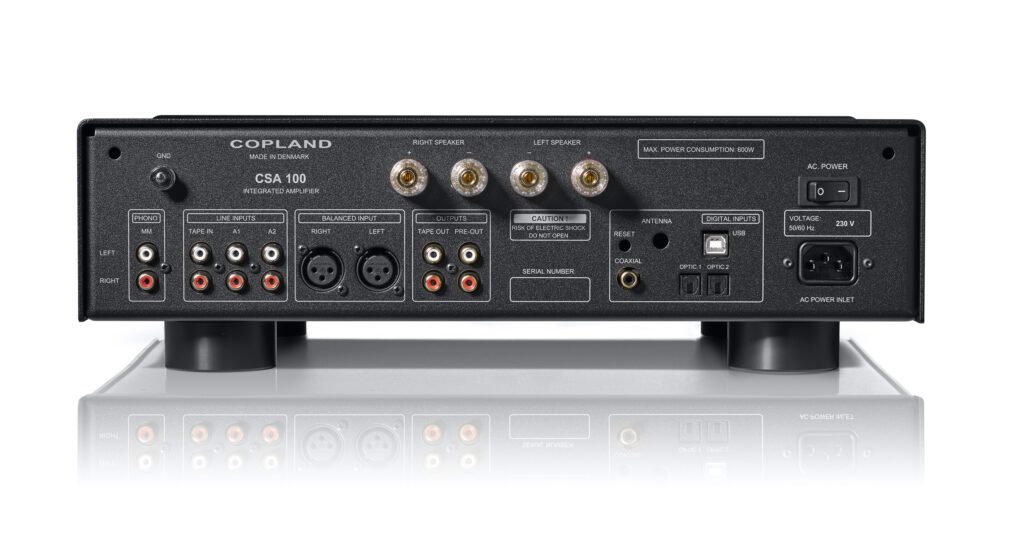
What it does so well is communicate that ‘holographic’ soundstaging that draws so many to good audio. The Copland CSA 100 has that in spades, creating a three-dimensional space in front of the listener that you feel is almost possible to reach out and touch. Any of those demonstration-quality ECM recordings are perfect partners here; all that oud-noodling (oudling?) by Anouar Brahem on albums like Blue Maqams or The Astounding Eyes of Rita is mesmerising here, filling the room with a North African/Middle Eastern vibe.
Clearly better
While that staging is what hooks you into the Copland’s sound, it’s the clarity and detail that are the real insights. The CSA 100 gives you a close look into the recording studio or venue; not in a brutishly hard analytical manner, but with the sort of detail and insight that just communicates the music extremely well. Audiophiles often have something of an obsession with finger noise on stringed instruments because it shows how good a device is in picking up very low-level information. Playing ‘May You Never’ by John Martyn {Solid Air, Island] gives excellent insight into the musician’s playing style and all those finger noises (often masked by his percussive playing style) come through well. The flip-side to this – The Glenn Gould/Keith Jarrett Sing-A-Long Hour – is also well resolved, but where some of the more aggressively detailed make Gould’s little snorts and hums irritating to the point they detract from his masterful playing, here they sit well in the Bach piece [Goldberg Variations, Sony]. And while that clarity is somewhat cool and collected, more cerebral than ‘shut up and dance’, few can match the CSA 100’s ability to communicate at the price.
There is good consistency across the inputs too, with no shifts in tone or character as you move from turntable to line input to digital. I’d argue that the RCA line inputs are mildly superior to XLR, that coaxial S/PDIF is marginally superior to Toslink optical and both are a hair better than USB, but unless you are playing the same track back to back through all these inputs, the difference are slight.
The headphone listening experience is one of the few places that requires qualification. While the likes of Sennheiser’s HD 25 II closed-back headphones sounded as clear as a bell and extremely detailed (they are popular with field recordists for a reason), the same did not apply with a pair of the late, lamented AudioQuest NightHawks I use for night-time listening, which sounded ‘peaky’ through the CSA 100.
I’ve been privy to two very different sounding hybrids in successive months, both of which come from the same Absolute Sounds stable. The £6,498 PrimaLuna EVO300 Hybrid is also a 100W integrated amplifier design, albeit one without a phono stage, a headphone amp or a DAC. It also uses six 12AU7 valves. The difference between the two is striking; the PrimaLuna is ‘punchy’ and yet ‘refined’ where the Copland is ‘detailed’ and ‘elegant’ sounding. The EVO300 Hybrid has more of a sonic imprint on the music, but that imprint is very attractive to some listeners.
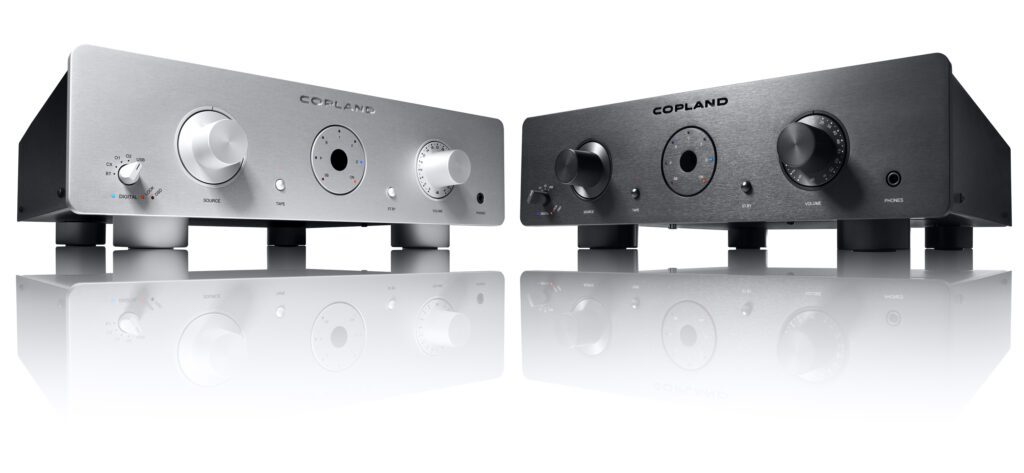
I’m often reluctant to put together combinations in print unless they absolutely sing together, but hooking the Copland CSA 100 to a pair of KEF LS50 Meta loudspeakers is one of those matches made in sonic heaven. Factor in your turntable of choice (I think EAT, Pro-Ject or Vertere would be a great visual and sonic match, but the built-in phono stage is a flexible friend), a good digital source and a cable system that brings out the best of both and in a small to medium sized listening room, that Copland/KEF combo is extremely hard to beat, giving you an extremely detailed and open sounding performance with outstanding soundstaging, boundless energy and a smoothness and satisfaction to the sound that is just… polished.
Metropolitan chic
I have banging on about ‘metropolitan’ high-end audio recently, and the Copland CSA 100 is perhaps the epitome of that concept. The amplifier’s size, features, abilities and classic design make it the kind of device that is made for chic city-dwelling living spaces rather than the dedicated listening rooms of those ‘estate’ listeners (for UK readers, that’s ‘estate’ in the ‘rambling country seat’ sense, and not a cheaply-built tower block in Thamesmead). So, where earlier I said – and still hold – that the CSA 100 is a gateway into high-end audio, it is also sufficiently good in its own right to be that high-end centrepiece in your London flat or your New York apartment.
It’s these last two elements that make the Copland CSA 100 so important in today’s audio world; it sounds sublime with real-world audio devices, showing just what good high-end audio is capable of, and does so in a package that’s as refined as its sound. That gives the amplifier a wider audience than just traditional audiophiles going through a spot of ‘electronics churn’. I suspect all three amps in this series will have universal appeal but the CSA 100 doesn’t suffer from ‘middle child syndrome’; it’s just possibly in the Goldilocks spot where everything just fits well.
Technical specifications
- Type Integrated amplifier with DAC and phono stage
- Power 2 × 100 watts into 8 ohms
- Analogue Inputs 1 × balanced (XLR),
- 3 × unbalanced (RCA)
- Digital Inputs 1 × coaxial S/PDIF, 2 × optical S/PDIF, 1 × USB, 1 × aptX HD Bluetooth (optional)
- Line Output 1 × unbalanced (RCA), 1 × pre-out unbalanced variable (RCA)
- Phono Input Impedance 47K ohms (MM)
- Frequency Response 10 Hz- 150 kHz -3dB
- THD Better than 0.06%
- Signal/Noise (IHF-A) Better than 90dB
- Headphone Amp Gain 22 dB @ 100 ohm load impedance
- Headphone output impedance 40Ω
- Vacuum Tubes 1 × 6922
- Remote Yes
- Dimensions (H×W×D) 135 × 435 × 370mm
- Shipping Weight 14 Kg
- Finishes Available Silver or Black
- Price £3,988
- Bluetooth Module £198
Manufacturer
Copland
UK Distributor
Absolute Sounds
+44(0)20 8971 3909
By Alan Sircom
More articles from this authorRead Next From Review
See all
PrimaLuna EVO 100 phono preamplifier
- Apr 22, 2024

Reiki Audio SuperSwitch Master Pro + Servant Pro
- Mar 27, 2024

Melco Audio N1-S38 music server
- Mar 27, 2024








